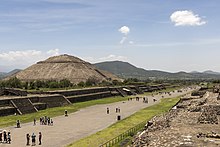Pyramid of the Sun from Teotihuacan
The pyramid of the sun is the second largest structure in pre-Hispanic Central America. It is located in the center of the pre-Aztec ruined city of Teotihuacán , around 40 km northeast of Mexico City . In the cityscape of Teotihuacán, the pyramid is located on the Street of the Dead between the Pyramid of the Moon and the Ciudadela in the shadow of the mighty Cerro Gordo massif.
history
The building was given the name "Pyramid of the Sun" by the Aztecs after the city had been deserted for centuries. The original name is unknown. The pyramid was built in two phases: The first phase took place around the year 100, whereby the pyramid had almost reached its present size. The second phase involved setting up an altar on the platform at the top of the pyramid, which has not been preserved. Since then, the pyramid has a footprint of around 225 m × 225 m and a height of around 63 meters, making it the third largest pyramid in the world. The Adosada Platform was added at the beginning of the 3rd century , around the same time that the Ciudadela and the Pyramid of the Feathered Serpent were built.
The entire structure was provided with a lime plaster on which the builders applied colorful paintings, but neither this plaster nor the paintings have survived the centuries. It is reported that the original depictions included images of jaguar heads and paws, stars, and snake rattles.
It is assumed that the pyramid was used to worship a deity worshiped in Teotihuacán without the name or character of this deity being known, especially since, as mentioned, the altar, which might have been able to provide information about it, is no longer preserved. Some researchers argue that the revered deity could have been some kind of archaic mother goddess , but this must remain speculation.
The first archaeological investigations of the pyramid of the sun were carried out by Leopold Bartres in 1906 , which have been followed by numerous other excavations and investigations to this day. Between 2008 and 2011, a total of five burial places were discovered on different levels inside the pyramid.
topography
The alignment of the pyramid is the subject of intense research. Astronomical backgrounds are not excluded. The most important axis of the structure points to the point of sunset on August 12 and April 20, which play an important role in the Mayan calendar .
A cave was discovered below the pyramid, which can be reached through an artificial tunnel. For a long time it was believed that the cave was of natural origin, but more recent research indicates that it was artificial. Archaeologists suspect royal tombs of older rulers here, about whom little or nothing is known so far. Several relics have been found and the tomb faces the opening.
Finds around the pyramid
Only a few finds were discovered in the pyramid and in its vicinity. These include obsidian arrowheads and human- shaped figures; Similar objects have also been found on the Pyramid of the Moon, the Pyramid of the Feathered Serpent, and the Ciudadela. At the corners of the pyramids, graves of children were found, who were apparently buried there as part of religious ceremonies.
literature
- Susan Toby Evans : Ancient Mexico and Central America , 2004
- Peter Gwin : Seeing Through Walls. National Geographic , February 2005
- Saburo Sugiyama : Governance and Polity at Classic Teotihuacan. Mesoamerican Archeology, 2005
See also
Web links
Individual evidence
- ↑ Burials inside the pyramid of the sun. In: academia.edu
- ↑ Searching for graves in the city of human sacrifices. In: Spiegel online , November 5, 2006
Coordinates: 19 ° 41 ′ 33 " N , 98 ° 50 ′ 37.5" W.

